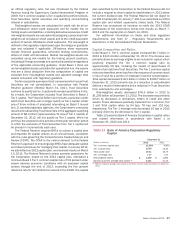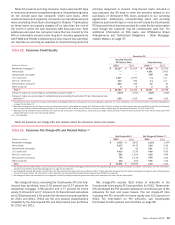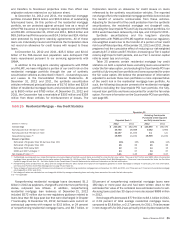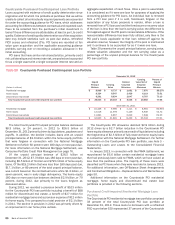Bank of America 2012 Annual Report Download - page 78
Download and view the complete annual report
Please find page 78 of the 2012 Bank of America annual report below. You can navigate through the pages in the report by either clicking on the pages listed below, or by using the keyword search tool below to find specific information within the annual report.76 Bank of America 2012
Consumer Portfolio Credit Risk Management
Credit risk management for the consumer portfolio begins with
initial underwriting and continues throughout a borrower’s credit
cycle. Statistical techniques in conjunction with experiential
judgment are used in all aspects of portfolio management
including underwriting, product pricing, risk appetite, setting credit
limits, and establishing operating processes and metrics to
quantify and balance risks and returns. Statistical models are built
using detailed behavioral information from external sources such
as credit bureaus and/or internal historical experience. These
models are a component of our consumer credit risk management
process and are used in part to help make both new and existing
credit decisions, as well as portfolio management strategies,
including authorizations and line management, collection practices
and strategies, determination of the allowance for loan and lease
losses, and economic capital allocations for credit risk.
Since January 2008, and through 2012, Bank of America and
Countrywide have completed approximately 1.2 million loan
modifications with customers. During 2012, we completed more
than 156,000 customer loan modifications with a total unpaid
principal balance of approximately $34 billion, including
approximately 41,400 permanent modifications under the
government’s Making Home Affordable Program. Of the loan
modifications completed in 2012, in terms of both the volume of
modifications and the unpaid principal balance associated with
the underlying loans, most were in the portfolio serviced for
investors and were not on our balance sheet. The most common
types of modifications include a combination of rate reduction
and/or capitalization of past due amounts which represented 54
percent of the volume of modifications completed in 2012, while
principal forbearance represented 18 percent, principal reductions
and forgiveness represented 17 percent and capitalization of past
due amounts represented seven percent. For modified loans on
our balance sheet, these modification types are generally
considered TDRs. For more information on TDRs and portfolio
impacts, see Nonperforming Consumer Loans and Foreclosed
Properties Activity on page 89 and Note 5 – Outstanding Loans
and Leases to the Consolidated Financial Statements.
Consumer Credit Portfolio
Improvement in the U.S. economy, labor markets and home prices
during 2012 resulted in lower credit losses across all major
consumer portfolios. Although home prices have shown signs of
improvement, the declines over the past several years continued
to adversely impact the home loans portfolio.
Improved credit quality across the consumer portfolio and the
impact of the National Mortgage Settlement, as discussed in the
following section, drove an $8.6 billion decrease in the consumer
allowance for loan and lease losses to $21.1 billion at
December 31, 2012. For more information, see Allowance for
Credit Losses on page 105.
As a result of the National Mortgage Settlement in 2012, which
among other things provided for borrower assistance, we recorded
charge-offs of $435 million related to fully forgiven non-PCI loans
in the home equity portfolio, which resulted in reductions of the
same amount in nonperforming loans. Associated with the
National Mortgage Settlement in 2012, we also fully forgave home
equity loans in the Countrywide PCI portfolio with a carrying value
before reserves of $2.5 billion and an unpaid principal balance of
$2.9 billion which resulted in a decrease in the corresponding
allowance for loan and lease losses. These items had no impact
on the provision for credit losses as these loans were fully
reserved. For more information on the National Mortgage
Settlement, see Off-Balance Sheet Arrangements and Contractual
Obligations – Other Mortgage-related Matters on page 57.
In 2012, new regulatory guidance was issued addressing
consumer real estate loans that have been discharged in Chapter
7 bankruptcy. In accordance with this new guidance, we now
classify consumer real estate and other secured consumer loans
that have been discharged in Chapter 7 bankruptcy and not
reaffirmed by the borrower, as TDRs, irrespective of payment
history or delinquency status, even if the repayment terms for the
loan have not been otherwise modified. We continue to have a lien
on the underlying collateral. Previously, such loans were classified
as TDRs only if there had been a change in contractual payment
terms that represented a concession to the borrower. The net
impact upon implementation to the consumer real estate and other
secured consumer portfolios of adopting this new regulatory
guidance was a $551 million increase in net charge-offs as these
loans were written-down to collateral value, and the full-year impact
was a $596 million increase in net charge-offs in 2012. This also
resulted in an increase of $3.6 billion in TDRs and $1.2 billion in
net new nonperforming loans upon implementation, of which $1.1
billion of such loans were included in nonperforming loans at
December 31, 2012. Of the $1.1 billion, $1.0 billion, or 92
percent, were current on their contractual payments. Of these
contractually current nonperforming loans, more than 70 percent
were discharged in Chapter 7 bankruptcy more than 12 months
ago, and more than 40 percent were discharged 24 months or
more ago. As subsequent cash payments are received, the interest
component of the payments is generally recorded as interest
income on a cash basis and the principal component is generally
recorded as a reduction in the carrying value of the loan. For more
information on the impacts to consumer loans as a result of this
new regulatory guidance, see Note 5 – Outstanding Loans and
Leases to the Consolidated Financial Statements.
In 2012, the bank regulatory agencies jointly issued
interagency supervisory guidance on nonaccrual status for junior-
lien consumer real estate loans. In accordance with this regulatory
interagency guidance, we now classify junior-lien home equity loans
as nonperforming when the first-lien loan becomes 90 days past
due even if the junior-lien loan is performing, and as a result, we
reclassified $1.9 billion of performing home equity loans to
nonperforming upon implementation, and $1.5 billion of such
loans were included in nonperforming loans at December 31,
2012. The regulatory interagency guidance had no impact on our
allowance for loan and lease losses or provision for credit losses
as the delinquency status of the underlying first-lien was already
considered in our reserving process. For more information, see
Consumer Portfolio Credit Risk Management – Home Equity on
page 83 and Table 21.
For further information on our accounting policies regarding
delinquencies, nonperforming status, charge-offs and TDRs for the
consumer portfolio, see Note 1 – Summary of Significant
Accounting Principles to the Consolidated Financial Statements.
























